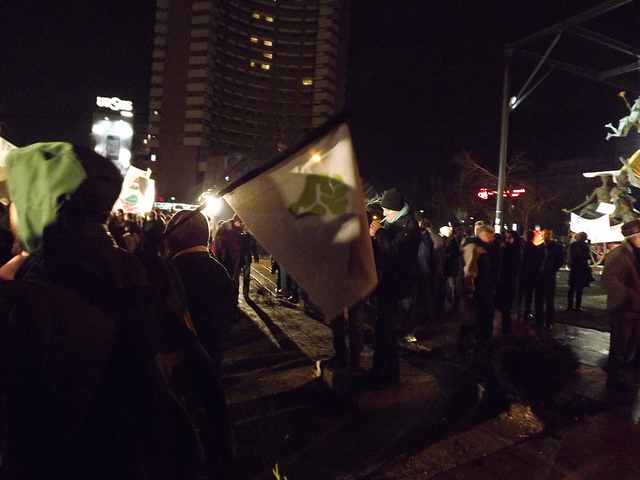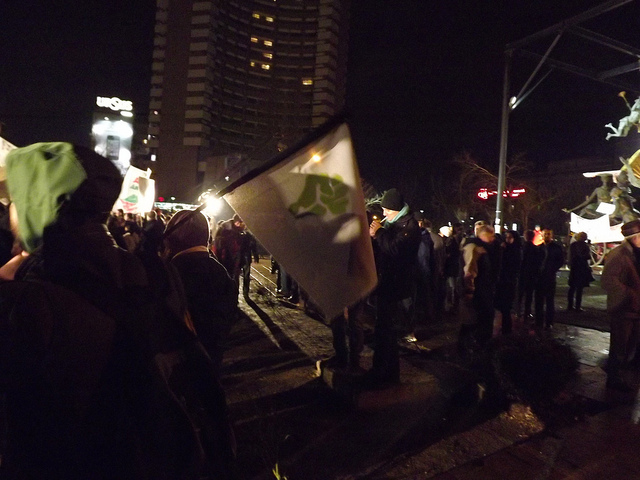
 The methods of nonviolent action are not weapons we turn to in a crisis; they are the tools of a democratic society. (Photo: Damiano Benzoni)
The methods of nonviolent action are not weapons we turn to in a crisis; they are the tools of a democratic society. (Photo: Damiano Benzoni)
The methods of nonviolent action are not weapons we turn to in a crisis. They are the tools of cultures and societies evolving toward justice, equality, respect, self-governance and sustainability.
A recent New York Times interview with Srdja Popovic, a former member of the Otpor movement that unseated Serbia’s Slobodan Milosevic, characterized nonviolent struggle as “nonviolent war.” While nonviolent struggle has proven to be twice as effective as violence in resolving many forms of intense conflict (Chenoweth and Stephan, Why Civil Resistance Works), it is inappropriate to frame nonviolent struggle as a form of warfare.
The methods of nonviolent action are not weapons we turn to in a crisis; they are the tools of a democratic society. They are essential components of the system of checks and balances, offering ordinary people the tools of boycotts, strikes, sit-ins, shut-downs, occupations, blockades, noncooperation, protest and persuasion, civil disobedience and more. The framework of these actions is not war; it is the daily, engaged participation of citizens of any society evolving toward justice, equality, respect, self-governance and sustainability.
The use of military rhetoric has a long history in nonviolent movements. Gandhi used the terms “nonviolent army” and “nonviolent soldiers.” The civil rights movement employed the phrases “warriors,” “lieutenants” and “militant nonviolence.” Yet, Gandhi also wisely pointed out that “means are ends in the making.” The rhetoric of violence – while convenient for gathering recruits and gaining respect in the eyes of a violence-driven culture – leads us down a dangerous path.
Framing nonviolent action as warfare may be a seductive description, but it places our movements in the context of terrorism, guerrilla war and insurgent groups. Once nonviolent action becomes culturally viewed as a form of warfare, it will become socially acceptable to repress such movements with drone strikes, snipers, assassination, mass arrests, disruption, entrapment, defamation of character, bombs, militarized ambushes and more. Organizers of nonviolent movements understand that many of these forms of repression can – and have been – used to destroy movements for change. But once our society views nonviolent movements as a form of warfare, violent repression becomes much more acceptable in the eyes of our people. Acts of protest and persuasion, which should be fully protected under our First Amendments rights, are already being repressed in the United States with arrests, tear gas, rubber-coated bullets, sound guns and pepper spray. What happens to the tools of democratic society when nonviolent action is considered warfare, and the government sends in the drones?
Already, the phrases “war on poverty” or “war on crime” have allowed the rise of the warrior-cop, the quasi-military figure who wages such a war. The phrase “eco-terrorist” is subtly sliding into popular usage, along with a tendency to frame all environmental activists under its umbrella. The term “class warfare” was cleverly twisted to refer to attacks on the wealthy, rather than being used to reflect the real, tangible assaults on the poor and low-income citizens who are dying at a rate of 75,000 per month due to poverty and poverty related social causes (Death by Poverty, Columbia University). In so many places in our culture, the rhetoric of violence is strangling justice and equality.
Using the term “nonviolent warfare” is defining our movements in the language of our oppressor. It is surrendering to the domination of our militarized nation, and conceding the point that we lack words to describe the place between passivity and violence. Yet, nonviolence has always been the third option between fight and flight, as Michael Nagler, senior adviser to the Metta Center For Nonviolence, points out in his book, The Nonviolence Handbook. Nonviolence is the choice to engage in conflict and seek a resolution or renegotiation of society, laws and power structure. Ken Butigan, director of Pace e Bene and Campaign Nonviolence, says that nonviolent action is “less battle than ballet.”
The metaphors of creativity and humanness are available to nonviolent movements. The ongoing slide toward militarization in the United States has defunded the arts and cultural programs, leaving our imaginations devoid of language outside of the corporate-consumer-military framework. We forget that as human beings, we are dancers, inventors, scientists, scholars, potters, weavers, bakers, painters, mothers, fathers, dreamers, poets and visionaries. We sweat, labor, lift, strive, work, dodge, dance, swirl, leap, remove, refuse, agree, collect, nurture, oppose, propose, demand, resolve, declare, rejoice and celebrate. This is the language of nonviolent movements. These are the metaphors of a people working for change. We are shaping a new world like potters at the wheel. We are singing for justice in a chorus of voices. We join hands together and dance circles around our oppressors. We push like a community raising a barn. We topple walls of oppression like builders opening space for common ground.
Language is powerful. Let’s use it wisely. Our words should place nonviolent action where it belongs: in the arena of justice, peace and democratic society. We are not armies or soldiers. We are the heart and soul of our nation. We are mothers, fathers, sisters and brothers, working together for change.
Join us in defending the truth before it’s too late
The future of independent journalism is uncertain, and the consequences of losing it are too grave to ignore. To ensure Truthout remains safe, strong, and free, we need to raise $46,000 in the next 7 days. Every dollar raised goes directly toward the costs of producing news you can trust.
Please give what you can — because by supporting us with a tax-deductible donation, you’re not just preserving a source of news, you’re helping to safeguard what’s left of our democracy.